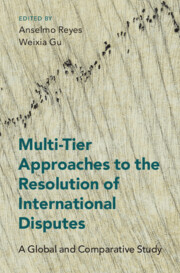Book contents
- Multi-tier Approaches to the Resolution of International Disputes
- Multi-tier Approaches to the Resolution of International Disputes
- Copyright page
- Contents
- Figures
- Tables
- Contributors
- Acknowledgements
- Table of Cases
- Table of STATUTES AND INSTRUMENTS
- Table of Rules, Codes and Guidelines
- Abbreviations
- Part I A Global Overview of Multi-tier Dispute Resolution: Main Themes
- Part II Multi-tier Dispute Resolution in Asia
- A General Trends
- 3 Combinations of Mediation and Arbitration
- 4 The Resolution of International Commercial and Financial Disputes
- 5 Multi-tier Dispute Resolution
- 6 Perspectives and Challenges of Multi-tier Dispute Resolution in Japan
- 7 Might There Be a Future for Multi-tiered Dispute Resolution in Korea?
- 8 Combinations of Mediation and Arbitration
- B Specific Cases
- Part III Multi-tier Dispute Resolution in the Wider World
- Part IV Conclusion
- Bibliography
- Index
6 - Perspectives and Challenges of Multi-tier Dispute Resolution in Japan
from A - General Trends
Published online by Cambridge University Press: 09 December 2021
- Multi-tier Approaches to the Resolution of International Disputes
- Multi-tier Approaches to the Resolution of International Disputes
- Copyright page
- Contents
- Figures
- Tables
- Contributors
- Acknowledgements
- Table of Cases
- Table of STATUTES AND INSTRUMENTS
- Table of Rules, Codes and Guidelines
- Abbreviations
- Part I A Global Overview of Multi-tier Dispute Resolution: Main Themes
- Part II Multi-tier Dispute Resolution in Asia
- A General Trends
- 3 Combinations of Mediation and Arbitration
- 4 The Resolution of International Commercial and Financial Disputes
- 5 Multi-tier Dispute Resolution
- 6 Perspectives and Challenges of Multi-tier Dispute Resolution in Japan
- 7 Might There Be a Future for Multi-tiered Dispute Resolution in Korea?
- 8 Combinations of Mediation and Arbitration
- B Specific Cases
- Part III Multi-tier Dispute Resolution in the Wider World
- Part IV Conclusion
- Bibliography
- Index
Summary
Multi-tier dispute resolution, a combination of mediation and arbitration or litigation, has recently been gaining in importance in international business transactions. While arbitration has the advantages of being confidential, professional and effective across borders owing to the 1958 New York Convention, mediation, geared towards amicable settlements, is time- and cost-efficient and supportive of preserving commercial relationships. Both methods can complement each other in ‘med-arb’, ‘arb-med’ or ‘arb-med-arb’. This chapter discusses cardinal issues surrounding multi-tier dispute resolution in Japan, particularly the enforcement of agreements to mediate as a condition precedent to arbitration or litigation, and the methods of combining mediation and arbitral procedures. At the same time, this contribution sheds light on recent developments and efforts being made in Japan to enhance international arbitration and mediation. This trend will soon bring about legislative reforms and may possibly result in the ratification of the 2019 Singapore Convention on Mediation.
Keywords
- Type
- Chapter
- Information
- Multi-Tier Approaches to the Resolution of International DisputesA Global and Comparative Study, pp. 142 - 160Publisher: Cambridge University PressPrint publication year: 2021



